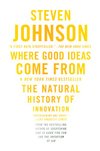
Saved by Brandon Marcus and
Where Good Ideas Come From

Saved by Brandon Marcus and
Wagner found that after an initial exposure to the numerical test, “sleeping on the problem” more than doubled the test subjects’ ability to discover the hidden rule.
One way or another, the noise had to be preserved, because without it, evolution would grind to a halt.
Something about the Web environment had enabled Hurley, Chen, and Karim to unleash a good idea on the world with astonishing speed. They took the 10/10 rule and made it 1/1.
When nature finds itself in need of new ideas, it strives to connect, not protect.
What the adjacent possible tells us is that at any moment the world is capable of extraordinary change, but only certain changes can happen.
know that during REM sleep acetylcholine-releasing cells in the brain stem fire indiscriminately, sending surges of electricity billowing out across the brain. Memories and associations are triggered in a chaotic, semirandom fashion, creating the hallucinatory quality of dreams.
every four hours they spend working on official company projects, the engineers are required to spend one hour on their own pet project, guided entirely by their own passions and instincts. (Modeled on a similar program pioneered by 3M known as “the 15-percent rule,” Google’s system is officially called “Innovation Time Off.”)
The social flow of the group conversation turns that private solid state into a liquid network.
Part of coming up with a good idea is discovering what those spare parts are, and ensuring that you’re not just recycling the same old ingredients.